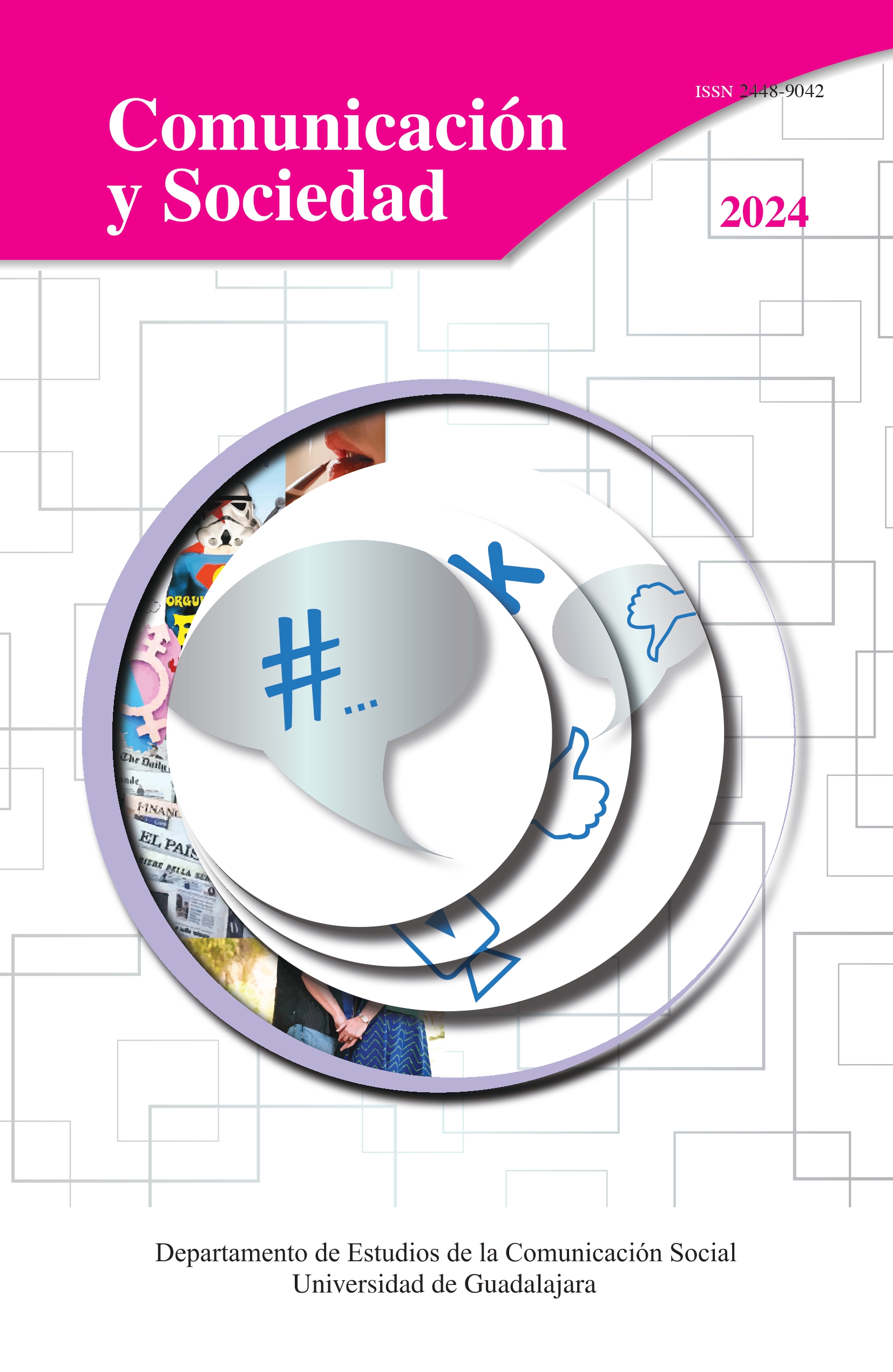Género, intimidad y poder: uso de medios digitales en interacciones románticas en jóvenes chilenos
DOI:
https://doi.org/10.32870/cys.v2024.8604Palabras clave:
Juventud, Relaciones personales, Género, Uso de Internet, Análisis cualitativo, TecnologíaResumen
Este trabajo explora las prácticas y sentidos que jóvenes universitarios chilenos (N = 60) despliegan en sus relaciones románticas mediadas por Internet, así como la normatividad de género que se instala en el espacio virtual. El enfoque es cualitativo y utiliza entrevistas semiestructuradas. Los resultados muestran la persistencia de códigos de género que restringen la sexualidad femenina, lo que evidencia cómo las desigualdades de poder simbólico se ven reforzadas en el ámbito de la virtualidad.Descargas
Citas
Arévalo, C. & Cuevas, A. (2022). Motivaciones de uso de Tinder en dos generaciones de adultos heterosexuales. En Z. Rodríguez & T. Rodríguez (Coords.), Parejas contemporáneas: De los arreglos tradicionales a las relaciones abiertas, la responsabilidad afectiva, el Tinder y el sugar dating (pp. 299-331). Universidad de Guadalajara.
Arnett, J. (2015). Emerging adulthood: The winding road from the late teens through the twenties. Oxford University Press.
Barrera-Herrera, A. & Vinet, E. (2017). Adultez Emergente y características culturales de la etapa en universitarios chilenos. Terapia Psicológica, 35(1), 47-56. https://teps.cl/index.php/teps/article/view/152
Bazeley, P. (2021). Qualitative Data Analysis: Practical strategies. sage.
Besoain, C., Sharim, D., Carmona, M., Bravo, D. & Barrientos, J. (2017). Sin conflicto y sin deseo: Las tensiones de la individualización en la experiencia de pareja de jóvenes chilenos. ces Psicología, 10(1), 109-128. https://doi.org/10.21615/cesp.10.1.9
boyd, d. (2014). It’s complicated: The social lives of networked teens. Yale University Press.
Cardon, D. (2009). L’identité comme stratégie relationnelle. Hermès, La Revue, 53, 61-66. https://doi.org/10.4267/2042/31477
Chambers, D. (2013). Social media and personal relationships: Online intimacies and networked friendship. Palgrave MacMillan.
Corona, S. & Rodríguez, Z. (2000). El amor como vínculo social, discurso e historia: Aproximaciones bibliográficas. Espiral. Estudios sobre Estado y Sociedad, 6(17), 49-70. http://www.espiral.cucsh.udg.mx/index.php/EEES/article/view/1157
Courtain, A. & Glowacz, F. (2018). Exploration of dating violence and related attitudes among adolescents and emerging adults. Journal of Interpersonal Violence, 36(5-6), 2975-2998. https://doi.org/10.1177/0886260518770185
Curran, M., McDaniel, B., Pollitt, A. & Totenhagen, C. (2015). Gender, emotion work and relationship quality: A daily diary study. Sex Roles, 73(3-4), 157-173. https://doi.org/10.1007/s11199-015-0495-8
Echauri, G. (2016). Hiperconectividad en las relaciones de pareja de estudiantes universitarios mexicanos. Revista Alter, Enfoques Críticos, 13, 93-109. https://shorturl.at/txzKZ
Ellison, N., Hancock, J. & Toma, C. (2012). Profile as promise: A framework for conceptualizing veracity in online dating self-presentations. New Media & Society, 14(1), 45-62. https://doi.org/10.1177/1461444811410395
Elliott, V. (2018). Thinking about the coding process in qualitative data analysis. The Qualitative Report, 23(11), 2850-2861. https://doi.org/10.46743/2160-3715/2018.3560
Fahs, B. & Swank, E. (2016). The other third shift? Women’s emotion work in their sexual relationships. Feminist Formations, 28(3), 46-69. https://doi.org/10.1353/ff.2016.0043
Feixa, C., Fernández-Planells, A. & Figueras-Maz, M. (2016). Generación Hashtag. Los movimientos juveniles en la era de la web social. Revista Latinoamericana de Ciencias Sociales, Niñez y Juventud, 14(1), 107-120. https://doi.org/10.11600/1692715x.1416301115
Freedman, G., Powell, D. & Williams, K. (2019). Ghosting and destiny: Implicit theories of relationships predict beliefs about ghosting. Journal of Social and Personal Relationships, 36, 905-924. https://doi.org/10.1177/0265407517748791
Galambos, N. L. & Martínez, M. L. (2007). Poised for emerging adulthood in Latin America: A pleasure for the privileged. Child Development Perspectives, 1, 109-114. https://doi.org/10.1111/j.1750-8606.2007.00024.x
Gómez-Urrutia, V. & Tello-Navarro, F. (2021). Gender, love and the Internet: romantic online interactions in Chilean young people. Journal of Youth Studies, 24(6), 731-745. https://doi.org/10.1080/13676261.2020.1764512
Hochberg, Z. & Konner, M. (2020). Emerging adulthood, a pre-adult life-history stage. Frontiers in Endocrinology, 10, Artículo 918. https://doi.org/10.3389/fendo.2019.00918
Instituto Nacional de Estadísticas de Chile-ine. (2019). Anuario de estadísticas vitales. https://bit.ly/3wKGIVt
Instituto Nacional de la Juventud de Chile-injuv. (2017). ¿Hacia una nueva juventud? Tendencias de la población juvenil en Chile (1998-2013). https://bit.ly/3Bbex4Z
Lara, L. & Gómez-Urrutia, V. (2021). Development and validation of the acceptance of dating violence questionnaire. Journal of Social and Personal Relationships, 39(4), 1110-1130. https://doi.org/10.1177/02654075211054154
Layder, D. (2009). Intimacy and power: The dynamics of personal relationships in modern society. Palgrave-MacMillan.
León, R. & Meza, S. (2018). Brecha en el uso de Internet: una expresión de la exclusión social. Fundación País Digital.
Malhi, N., Oliffe, J., Bungay, V. & Kelly, M. T. (2020). Male perpetration of adolescent dating violence: A scoping review. American Journal of Men’s Health, 14(5), 1-15. https://doi.org/10.1177/1557988320963600
Miguel, C. (2018). Personal relationships and intimacy in the age of social media. Palgrave Pivot.
Nydegger, L., DiFranceisco, W., Quinn, K. & Dickson-Gomez, J. (2017). Gender norms and age-disparate sexual relationships as predictors of intimate partner violence, sexual violence, and risky sex among adolescent gang members. Journal of Urban Health, 94(2), 266-275. https://doi.org/10.1007/s11524-016-0068-3
Oxfam. (2018). Rompiendo moldes: transformar imaginarios y normas sociales para eliminar la violencia contra las mujeres. https://bit.ly/3Q2rF07
Pangrazio, L. (2019a). Technologically situated: the tacit rules of platform participation. Journal of Youth Studies, 22(10), 1308-1326. https://doi.org/10.1080/13676261.2019.1575345
Pangrazio, L. (2019b). Young people’s literacies in the digital age. Continuities, conflicts and contradictions. Routledge.
Pinsky, D. (2019). Doing gender online through flirtation. Reset. Recherches en Sciences Sociales Sur Internet, (8), 1-18. https://doi.org/10.4000/reset.1303
Pinsky, D. (2022). Digitally mediated communication and school-based sex education in the USA. Sex Education, 23(5), 556-569. https://doi.org/10.1080/14681811.2022.2098469
Rodríguez, T. & Rodríguez, Z. (2016). El amor y las nuevas tecnologías: experiencias de comunicación y conflicto. Comunicación y Sociedad, (25), 15-41. https://doi.org/10.32870/cys.v0i25.4420
Rodríguez, T. & Rodríguez, Z. (2020). Intimidad y relaciones de pareja durante la pandemia de la Covid-19 en Guadalajara. Espiral. Estudios sobre Estado y Sociedad, 27(78), 215-268. https://doi.org/10.32870/eees.v28i78-79.7206
Reed, L., Ward, L., Tolman, R., Lippman, J. & Seabrook, R. C. (2018). The association between stereotypical gender and dating beliefs and digital dating abuse perpetration in adolescent dating relationships. Journal of Interpersonal Violence, 36(9-10), 5561-5585. https://doi.org/10.1177/0886260518801933
Rosenfeld, M. J., Thomas, R. J. & Hausen, S. (2019). Disintermediating your friends: How online dating in the United States displaces other ways of meeting. Proceedings of the National Academy of Sciences of the United States of America, 116(36), 17753-17758. https://doi.org/10.1073/pnas.1908630116
Saldaña, J. (2009). The coding manual for qualitative researchers. sage.
Syed, M. & Nelson, S. (2015). Guidelines for establishing reliability when coding narrative data. Emerging Adulthood, 3(6), 375-387. https://doi.org/10.1177/2167696815587648
Tello, F. & Gómez, V. (2017). Bitácora Social: Relaciones románticas y uso de tecnología digital entre los jóvenes chilenos. Facultad de Ciencias Sociales y Humanidades. Universidad Autónoma de Chile. https://bit.ly/3ebT9mY
Tillman, K., Brewster, K. & Holway, G. (2019). Sexual and romantic relationships in young adulthood. Annual Review of Sociology, (45), 133-153. http://dx.doi.org/10.1146/annurev-soc-073018-022625
Universidad Católica de Chile-Adimark. (2019). Resultados Encuesta Bicentenario- Familia. https://bit.ly/3q4jg1C
Wood, D., Crapnell, T., Lau, L., Bennett, A., Lotstein, D., Ferris, M. & Kuo, A. (2018). Emerging Adulthood as a Critical Stage in the Life Course. En N. Halfon, C. Forrest, R. Lerner & E. Faustman (Eds.), Handbook of Life Course Health Development (pp. 123-144). Springer. https://doi.org/10.1007/978-3-319-47143-3_7
Descargas
Publicado
Cómo citar
Número
Sección
Licencia

Esta obra está bajo una licencia internacional Creative Commons Atribución-NoComercial 4.0.
Los autores/as que publiquen en esta revista aceptan las siguientes condiciones:
De acuerdo con la legislación de derechos de autor, los autores conservan los derechos de autoría y otorgan a Comunicación y Sociedad el derecho de primera comunicación pública de la obra. Comunicación y Sociedad no realiza cargos a los autores por enviar y procesar artículos para su publicación.
Los autores/as pueden realizar otros acuerdos contractuales independientes y adicionales para la distribución no exclusiva de la versión del artículo publicado en Comunicación y Sociedad (por ejemplo incluirlo en un repositorio institucional o publicarlo en un libro) siempre que indiquen claramente que el trabajo se publicó por primera vez en Comunicación y Sociedad.











